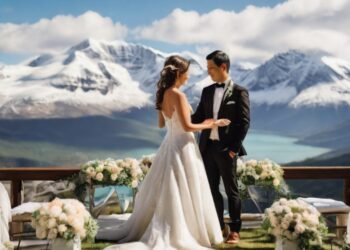Trend towards inclusive and diverse weddings
The trend towards inclusive and diverse weddings has been growing in recent years as couples seek to make their special day more reflective of their beliefs, values, and identities. From same-sex weddings to interfaith ceremonies, from accessible venues to eco-friendly decorations, there are many ways that couples can create a wedding that is not only beautiful but also inclusive and diverse.
One of the most significant developments in the wedding industry in recent years has been the legalization of same-sex marriage in many countries around the world. This has opened up new possibilities for LGBTQ+ couples to celebrate their love and commitment in a meaningful way. Same-sex weddings can be as traditional or as creative as any other wedding, but they often include unique touches that reflect the couple’s identity and relationship. For example, a same-sex couple may choose to walk down the aisle together rather than having one partner wait at the altar. They may also choose to incorporate symbols of LGBTQ+ pride, such as rainbow colors or the pink triangle, into their décor or attire.
Another way that weddings are becoming more inclusive and diverse is through interfaith ceremonies. As the world becomes more globalized, many couples are finding that they come from different religious backgrounds, and they want to honor both of their traditions in their wedding ceremony. Interfaith weddings can be challenging to plan, as they require careful consideration of each partner’s beliefs and customs. However, they can also be incredibly meaningful and enriching, as they provide an opportunity for the couple to learn from and appreciate each other’s faiths. Interfaith ceremonies may include elements such as readings from both religious texts, prayers in different languages, and blessings from both sets of parents.

Accessibility is another important consideration for couples who want to create an inclusive and diverse wedding. Many venues and services are not designed with accessibility in mind, which can make it difficult for guests with disabilities to participate fully in the celebration. To make a wedding more accessible, couples can choose a venue that is wheelchair accessible and has accessible restrooms. They can also provide sign language interpreters for deaf guests and make sure that the menu is clearly labeled for guests with dietary restrictions. Making these accommodations shows that the couple values and respects all of their guests, regardless of their abilities.
Eco-friendliness is another trend that is gaining traction in the wedding industry. Many couples are recognizing that weddings can be incredibly wasteful, with disposable decorations, single-use plastics, and excessive energy consumption. By choosing eco-friendly options, couples can reduce their carbon footprint and contribute to a more sustainable future.
Eco-friendly options can include using locally sourced and seasonal flowers, using recyclable or biodegradable materials for decorations, and serving vegetarian or vegan meals. Couples can also choose to donate to environmental causes instead of giving traditional wedding favors.
In addition to these trends, there are many other ways that couples can make their weddings more inclusive and diverse. For example, they may choose to have a multicultural wedding that incorporates elements of both partners’ cultures. This could include serving traditional foods from both cultures, playing music from both cultures, and having the wedding party wear attire that represents both cultures. Alternatively, couples may choose to have a non-traditional wedding that breaks away from conventional gender roles, such as having a bride wear a suit or having the wedding party be co-ed.
Overall, the trend towards inclusive and diverse weddings is a positive development in the wedding industry. It reflects a growing recognition that love and commitment come in many forms and that weddings should be a celebration of that diversity. By embracing these trends, couples can create a wedding that is not only beautiful but also meaningful and reflective of their values and beliefs.
However, it is important to remember that creating an inclusive and diverse wedding is not just about incorporating trendy elements into the ceremony. It is also about creating an atmosphere of inclusivity and respect throughout the planning process and on the day of the wedding itself.
This means being mindful of the language used when communicating with vendors and guests and avoiding assumptions about people’s identities or beliefs. It also means being open to feedback and willing to make changes to ensure that all guests feel welcome and included.
Inclusivity and diversity should also extend to the wedding party. Couples should feel free to choose whoever they want to stand beside them on their special day, regardless of gender, sexual orientation, or any other characteristic. Having a diverse wedding party can also provide an opportunity to showcase different styles and cultures and to celebrate the unique personalities of each individual.
It is also important to recognize that not all couples have the same resources or support when it comes to planning their wedding. Some may face financial barriers, discrimination, or other challenges that make it difficult to create the wedding of their dreams. In order to promote inclusivity and diversity in the wedding industry, it is important to support and uplift couples from all backgrounds and to work towards making weddings more accessible and affordable for everyone.

Conclusion
The trend towards inclusive and diverse weddings reflects a growing desire to create meaningful and inclusive celebrations of love and commitment. By embracing this trend, couples can create a wedding that is reflective of their values, beliefs, and identities while also promoting inclusivity and diversity in the wedding industry as a whole. However, it is important to approach this trend with intentionality and mindfulness and to recognize that creating an inclusive and diverse wedding requires ongoing effort and commitment. By doing so, couples can create a truly unforgettable wedding that celebrates the diversity and richness of the human experience.
As the wedding industry continues to evolve, it is important for couples to have the freedom to celebrate their love in a way that feels authentic and meaningful to them. Inclusive and diverse weddings allow couples to create a personalized experience that honors their unique backgrounds and identities while also creating an environment that is welcoming and inclusive for all guests.
The trend towards inclusivity and diversity is not just a passing fad; it is a reflection of the changing social landscape and the desire for greater acceptance and understanding. By incorporating elements such as same-sex weddings, interfaith ceremonies, accessibility, eco-friendliness, and multiculturalism, couples can create a wedding that truly reflects who they are and what they stand for.
At the same time, it is important to recognize that the journey towards inclusivity and diversity is ongoing and that there is always more work to be done. The wedding industry must continue to evolve and adapt to meet the changing needs and desires of couples from all backgrounds. This means being open to feedback, listening to the voices of marginalized communities, and making meaningful changes to promote greater inclusivity and diversity.















